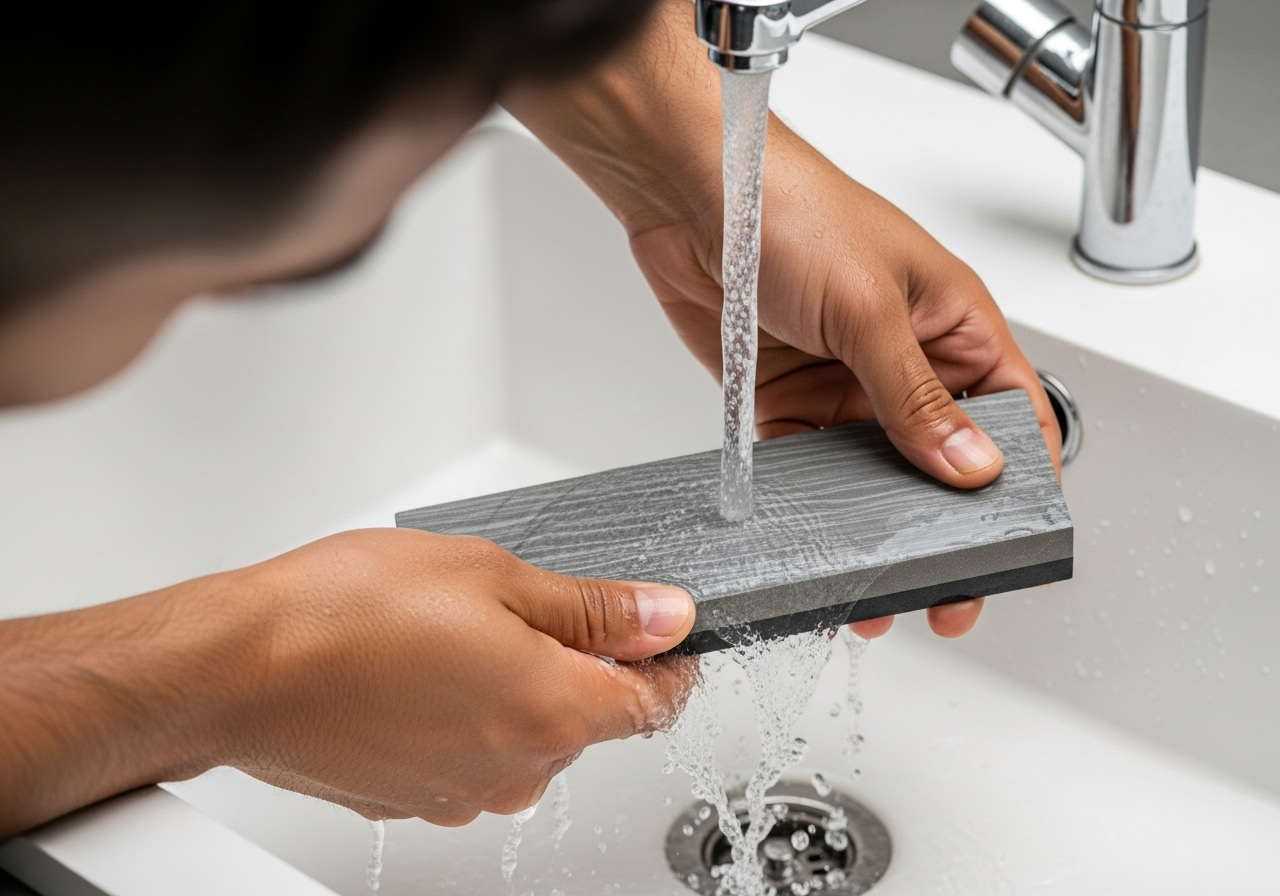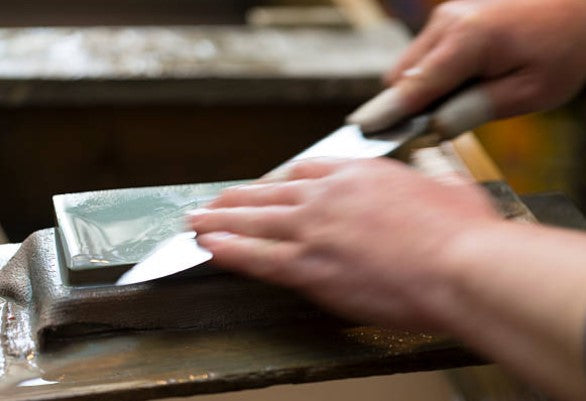
FAQ: Whetstones
-
-
Sharpening a knife is more than maintenance — it is a dialogue between blade and hand.
While the process may seem daunting at first, the truth is simple: with the right whetstone and clear guidance, anyone can learn to sharpen with confidence.
At KIREAJI, we share not only practical answers to common questions but also the tradition behind them. In Sakai, where craftsmen have perfected blades for over 600 years, sharpening is seen as the moment when the knife and its owner truly connect.
This FAQ will help you avoid common mistakes, understand the role of different whetstones, and embrace sharpening as a skill that not only preserves your knife — but also deepens your relationship with it.
FAQ About Whetstone

Q1. I don’t own a whetstone. Can I just use a sharpener instead?
Whetstones and sharpeners serve very different purposes. A whetstone allows you to properly shape, thin, and refine the entire edge of your knife, creating a lasting sharpness that grows with use. A sharpener, on the other hand, provides only a quick touch-up to restore performance temporarily. For anyone who values true sharpness and long-term results, a whetstone is essential.
Q2. How often should I sharpen my knives?
The frequency depends on your goal. If your only aim is to “cut food,” then sharpen when the knife feels dull. But if you care about enhancing flavor and texture, more frequent sharpening is important, because a perfectly sharpened knife preserves the structure of ingredients and maximizes taste. For home cooks, sharpening every one to three months is typical. For professionals or passionate cooks, sharpening weekly or even daily may be ideal.
Q3. That black, muddy substance appears when I sharpen—what is it?
That dark slurry is a mixture of metal from your knife and grit from the whetstone. It may look messy, but it actually plays an important role in refining and polishing the blade during sharpening.
Q4. Should I rinse off the slurry or keep sharpening on it?
Both approaches are correct. Continuing to sharpen on the slurry speeds up the process and creates a slightly softer edge. Rinsing it away with water allows for more precise, controlled sharpening. Which method you choose depends on whether you value efficiency or precision.
Q5. How much pressure should I apply when sharpening?
Apply only as much pressure as you could maintain for an hour without discomfort. The stone should do most of the work. Pressing too hard can damage both the edge and the stone.
Q6. My whetstone looks uneven. Can I fix it?
Yes. Using a resurfacing stone—also called a flattening stone—you can restore the whetstone’s flat surface. Regular flattening ensures consistent and reliable sharpening results.
Q7. My whetstone has cracked. Is it still usable?
Small cracks can sometimes be resurfaced and used with caution. But once cracks grow larger—especially if the stone has become thin—it is safer to replace it, as breakage during sharpening can be dangerous.
Q8. My knife suddenly slides easily on the stone. Is it clogged?
If the stone felt rough at first and then became slippery, it is likely clogged with residue. Resurfacing usually restores its texture. If the stone feels slippery from the beginning, it may not match your knife well, especially with certain stainless steels, though using the sharpening slurry can improve grip.
Q9. Do I need to soak my resurfacing stone before use?
Yes, a short soak enhances its performance. However, if you are using a diamond resurfacing stone, soaking is not necessary.
Q10. I struggle with sharpening. Any beginner-friendly advice?
Sharpening takes time, so don’t get discouraged. True skill comes from combining knowledge with practice. Read a reliable sharpening guide, practice on your knives, and return to the guide as your experience grows. What seems complex at first often makes sense after hands-on practice. With patience, anyone can master sharpening and unlock the full potential of their knives.

Types of Whetstones
Owning a fine knife means choosing the right whetstone to care for it. From coarse to finishing stones, each plays a role in sharpening and maintenance. Understanding their differences helps you keep your blade at peak performance and know how often to use each one.

Daily Care of Whetstones
Whetstones need only minimal upkeep, yet issues like warping or denting can affect their performance. With proper care, your stone stays in top condition—ensuring precise, effective sharpening every time.

The Soul of Craftsmanship
-
A Sharp Knife Begins with the Stone
The foundation of cooking is cutting, and the foundation of cutting is sharpening. No matter how fine the steel or how skillfully the knife is forged, its true brilliance only emerges when it meets the whetstone.
-
Sharpening is not simply about restoring sharpness. It is a dialogue between craftsman, stone, and steel—a process where patience, sensitivity, and respect come together. With each stroke across the stone, the knife regains its edge, and the user refines their connection to the craft of cooking.
-
As artisans, we believe that a whetstone is not just a tool for maintenance, but the soul that sustains a knife’s life. By caring for your blade through sharpening, you also nurture your own skills and deepen your appreciation for the ingredients.
-
If our knives, cared for with a whetstone, can bring even a small spark of joy to your cooking, that is the greatest reward for us.

Experience the sharpness trusted by 98% of Japan’s top chefs — handcrafted in Sakai City.
Through our exclusive partnership with Shiroyama Knife Workshop, we deliver exceptional Sakai knives worldwide. Each knife comes with free Honbazuke sharpening and a hand-crafted magnolia saya, with optional after-sales services for lasting confidence.
KIREAJI's Three Promises to You
-

1. Forged in the Legacy of Sakai
From Sakai City—Japan’s renowned birthplace of professional kitchen knives—each blade is crafted by master artisans with over six centuries of tradition. Perfectly balanced, enduringly sharp, and exquisitely finished, every cut carries the soul of true craftsmanship.
-

2. Thoughtful Care for Everyday Use
Every knife includes a hand-fitted magnolia saya for safe storage. Upon request, we offer a complimentary Honbazuke final hand sharpening—giving you a precise, ready-to-use edge from day one.
-

3. A Partnership for a Lifetime
A KIREAJI knife is more than a tool—it is a lifelong companion. With our bespoke paid aftercare services, we preserve its edge and beauty, ensuring it remains as precise and dependable as the day it first met your hand.



